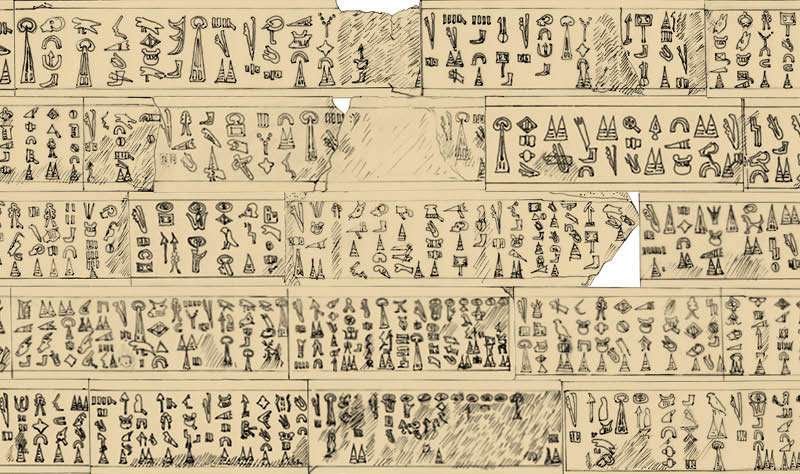Invasion Of Mysterious Sea People – Enigmatic 3,200-Year-Old Luwian Hieroglyphic Inscription Sheds New Light On Ancient Puzzle
AncientPages.com - In 1878, archaeologists discovered a stone slab covered with ancient symbols in modern Turkey. The 29-meter-long bears the longest known hieroglyphic inscription from the Bronze Age. It is a Luwian hieroglyphic inscription and only a handful of scholars have been able to decipher it.
This enigmatic stone describes the events at the end of the Bronze Age in the Eastern Mediterranean and sheds new light on one of the greatest puzzles of Mediterranean archaeology.
Although many theories have been presented there is little solid information about the mysterious Sea People.
Their nationality remains a mystery as the only records we have of their activities are mainly Egyptian sources who only describe them in terms of battle (such as the record from the Stele at Tanis which reads, in part, “They came from the sea in their war ships and none could stand against them”).
Luwian Hieroglyphic inscription by the Great King of Mira, Kupanta-Kurunta, composed at about 1180 BC. Credit: Luwian Studies
The term ‘Sea Peoples’ refer to nine groups of people, but the historical inscriptions give indications only to three of them, namely, the Sherden, Shekelesh, and Eqwesh.
The first translation of the Luwian hieroglyphic inscription has offered an explanation for the collapse of the Bronze Age's powerful and advanced civilizations.
The inscription and a summary of its contents also appear in a book by Eberhard Zangger that is being published in Germany today: Die Luwier und der Trojanische Krieg – Eine Forschungsgeschichte.
See also:
Life Of Galilean Sages Described On 1,800-Year-Old Hebrew Inscriptions Can Confirm Ancient Legends
The script tells how a united fleet of kingdoms from western Asia Minor raided coastal cities on the eastern Mediterranean.
It suggests they were part of a marauding seafaring confederation, which historians believe played a part in the collapse of those nascent Bronze Age civilizations.
Researchers believe the inscriptions were commissioned in 1190 BC by Kupanta-Kurunta, the king of a late Bronze Age state known as Mira.
The text suggests the kingdom and other Anatolian states invaded ancient Egypt and other regions of the east Mediterranean before and during the fall of the Bronze Age. When Kupanta-Kurunta had reinforced his realm, just before 1190 BC, he ordered his armies to storm toward the east against the vassal states of the Hittites.
After successful conquests on land, the united forces of western Asia Minor also formed a fleet and invaded a number of coastal cities (whose names are given) in the south and southeast of Asia Minor, as well as in Syria and Palestine. Four great princes commanded the naval forces, among them Muksus from the Troad, the region of ancient Troy. The Luwians from western Asia Minor advanced all the way to the borders of Egypt, and even built a fortress at Ashkelon in southern Palestine.
According to this inscription, the Luwians from western Asia Minor contributed decisively to the so-called Sea Peoples' invasions – and thus to the end of the Bronze Age in the eastern Mediterranean.
Copyright © AncientPages.com All rights reserved. This material may not be published, broadcast, rewritten or redistributed in whole or part without the express written permission of AncientPages.com
More From Ancient Pages
-
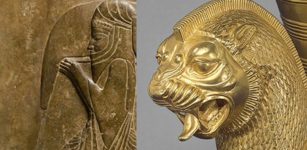 Peace Of Callias – A Treaty That Ended The Greco-Persian Wars
Ancient History Facts | May 15, 2019
Peace Of Callias – A Treaty That Ended The Greco-Persian Wars
Ancient History Facts | May 15, 2019 -
 Discovered Roman Malting Oven Could Be Evidence Of 2,000-Year-Old Beer Production In The UK
Archaeology | Apr 4, 2022
Discovered Roman Malting Oven Could Be Evidence Of 2,000-Year-Old Beer Production In The UK
Archaeology | Apr 4, 2022 -
 ‘Reforms of Shang Yang’ – Location Of Ancient Yueyang – Confirmed
Archaeology | Jan 25, 2016
‘Reforms of Shang Yang’ – Location Of Ancient Yueyang – Confirmed
Archaeology | Jan 25, 2016 -
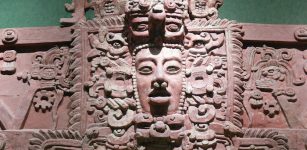 Fixing Archaeology’s Dating Problem – New Method Developed By Scientists
Archaeology | Sep 17, 2021
Fixing Archaeology’s Dating Problem – New Method Developed By Scientists
Archaeology | Sep 17, 2021 -
 Giant 4,500-Year-Old Axe Grinding Site Discovered In Scotland
Archaeology | Dec 13, 2022
Giant 4,500-Year-Old Axe Grinding Site Discovered In Scotland
Archaeology | Dec 13, 2022 -
 Mysterious 2,000-Year-Old Disco Colgante – Unknown High-Tech Device, Representation Of A Spiral Galaxy Or Something Else?
Artifacts | Nov 20, 2020
Mysterious 2,000-Year-Old Disco Colgante – Unknown High-Tech Device, Representation Of A Spiral Galaxy Or Something Else?
Artifacts | Nov 20, 2020 -
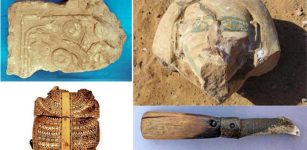 20 Mummies Discovered In Greco-Roman Tombs In Aswan, Egypt
Archaeology | Jan 21, 2022
20 Mummies Discovered In Greco-Roman Tombs In Aswan, Egypt
Archaeology | Jan 21, 2022 -
 Algonquin People And The Myth Of The Medicine Woman In The Moon
Featured Stories | Feb 1, 2016
Algonquin People And The Myth Of The Medicine Woman In The Moon
Featured Stories | Feb 1, 2016 -
 Birth Of Good And Evil In Iroquois Beliefs
Featured Stories | Sep 23, 2019
Birth Of Good And Evil In Iroquois Beliefs
Featured Stories | Sep 23, 2019 -
 Ruins Of 2,300-Year-Old City Of Jiaohe On The Silk Road
Civilizations | Aug 6, 2023
Ruins Of 2,300-Year-Old City Of Jiaohe On The Silk Road
Civilizations | Aug 6, 2023 -
 St. Swithin’s Day And The 40 Days’ Weather Prophecy
Featured Stories | Jul 15, 2023
St. Swithin’s Day And The 40 Days’ Weather Prophecy
Featured Stories | Jul 15, 2023 -
 Sacred Hidden Buyan Island And The Mysterious Alatyr Stone With Healing Powers May Have Existed
Featured Stories | Mar 22, 2018
Sacred Hidden Buyan Island And The Mysterious Alatyr Stone With Healing Powers May Have Existed
Featured Stories | Mar 22, 2018 -
 The Mystery Of Ancient Ever-Burning Lamps
Ancient Technology | Sep 10, 2024
The Mystery Of Ancient Ever-Burning Lamps
Ancient Technology | Sep 10, 2024 -
 Unexplained Visions Of Airmen – Controversial Investigation – Part 2
Featured Stories | Feb 9, 2020
Unexplained Visions Of Airmen – Controversial Investigation – Part 2
Featured Stories | Feb 9, 2020 -
 Ancient ‘Cosmic’ Artifacts – Ancient Civilizations Used Meteoric Iron Much Earlier Than Previously Thought
Archaeology | Dec 6, 2017
Ancient ‘Cosmic’ Artifacts – Ancient Civilizations Used Meteoric Iron Much Earlier Than Previously Thought
Archaeology | Dec 6, 2017 -
 How And When Did Ancient People Start Using Oil?
Ancient History Facts | Jun 28, 2018
How And When Did Ancient People Start Using Oil?
Ancient History Facts | Jun 28, 2018 -
 Valuable Ancient Celtic Gold Coins Found By Birdwatcher – A War Chest For Queen Boudicca’s Campaign?
Archaeology | Jan 5, 2021
Valuable Ancient Celtic Gold Coins Found By Birdwatcher – A War Chest For Queen Boudicca’s Campaign?
Archaeology | Jan 5, 2021 -
 Ötzi Had Dark Skin, Bald Head And Anatolian Ancestry- DNA Reveals
Evolution | Aug 16, 2023
Ötzi Had Dark Skin, Bald Head And Anatolian Ancestry- DNA Reveals
Evolution | Aug 16, 2023 -
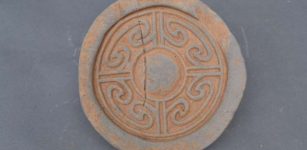 Discovered Inscription On Ancient Stone Vessel Reveals Location Of Legendary Tomb Of Chinese Emperor
Archaeology | Jan 11, 2021
Discovered Inscription On Ancient Stone Vessel Reveals Location Of Legendary Tomb Of Chinese Emperor
Archaeology | Jan 11, 2021 -
 On This Day In History: John Dee, English Mathematician, Occultist, Astrologer, Astronomer Was Born – On July 13, 1527
News | Jul 13, 2016
On This Day In History: John Dee, English Mathematician, Occultist, Astrologer, Astronomer Was Born – On July 13, 1527
News | Jul 13, 2016

